Abstract
Twelve cyclists and 12 long distance runners matched for age, height, and weight with two control groups of 12 non-athletes were studied echocardiographically to evaluate cardiac structure and function. Runners weighed 8 kg less than cyclists, but age and height were similar. Peak oxygen uptake per kg body weight was higher in athletes than in the control subjects but was similar in the cyclists and in the runners. The athletes' hearts had a larger end diastolic left ventricular internal diameter, mean wall thickness, and cross sectional area of the left ventricular wall than those of the respective control subjects. Nevertheless, whereas the left ventricular internal diameter was not different between the cyclists and runners, mean wall thickness and cross sectional area of the left ventricular wall were greater in the cyclists even after adjustment for weight. The ratio of wall thickness to left ventricular internal radius was significantly larger in cyclists than in their control group, but the ratio was similar in runners and their control group. The echocardiographic indices of left ventricular function were similar in the athletes and the control groups. Systolic left ventricular meridional wall stress was lower in the cyclists than in the runners. The data suggest that runners develop an increase in left ventricular wall thickness which is proportionate to the internal diameter but that in cyclists the increase is disproportionate because of the isometric work of the upper part of the body during cycling.
Full text
PDF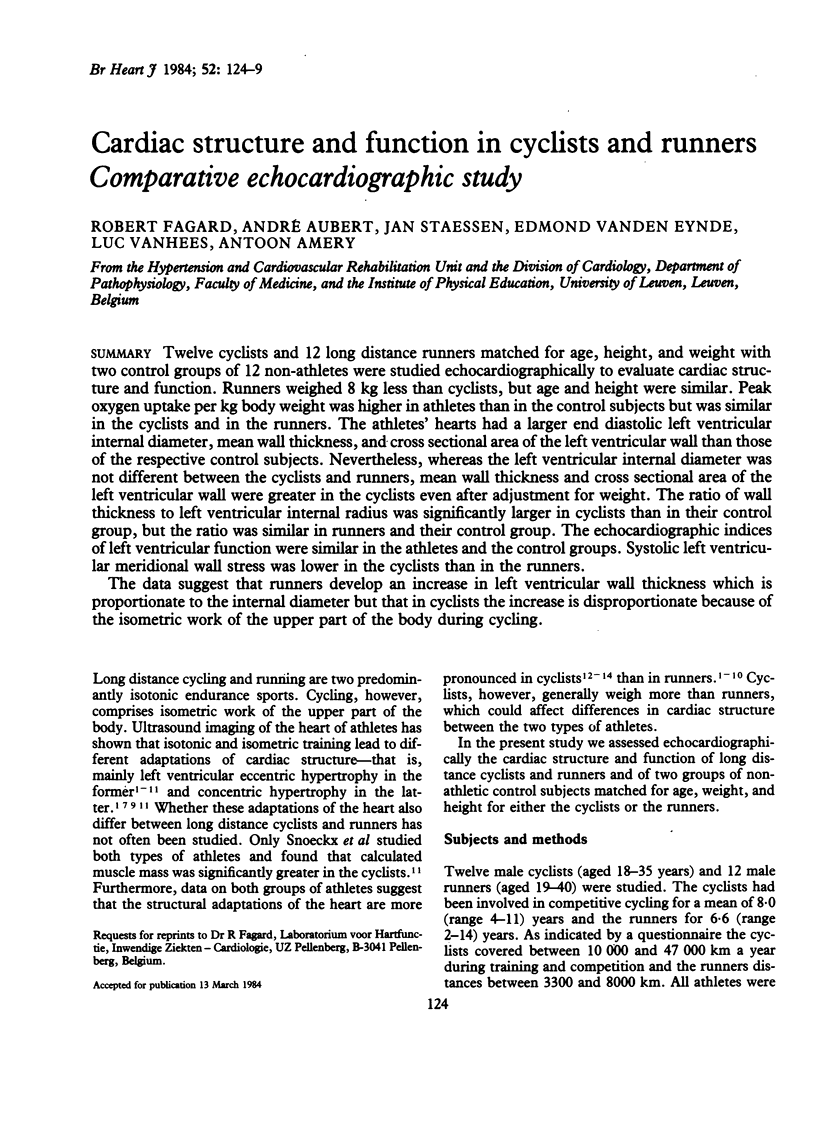
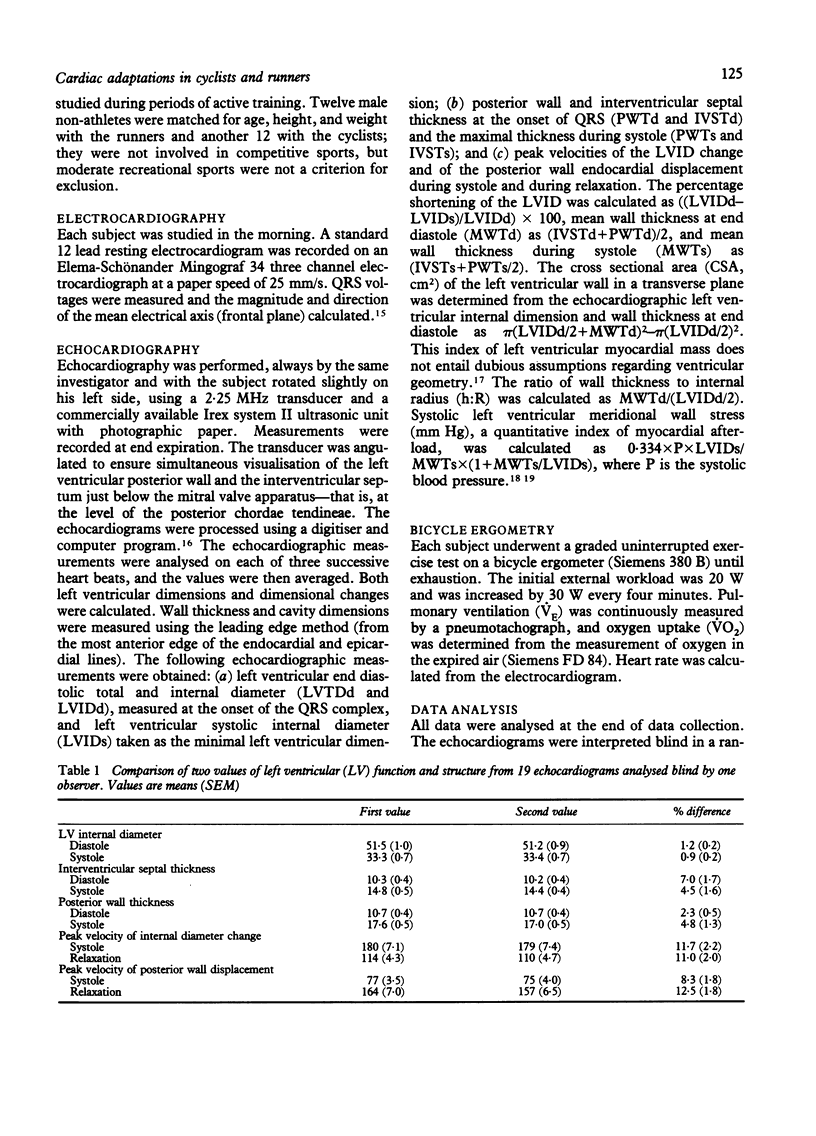
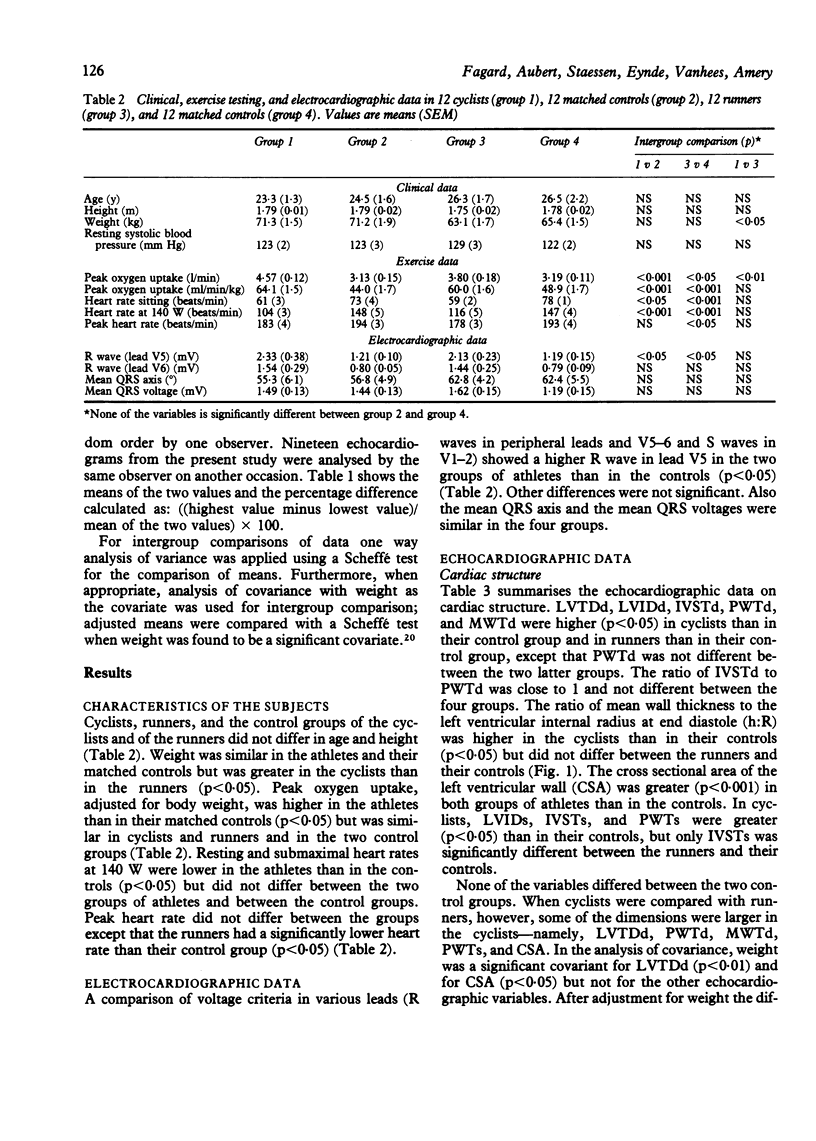
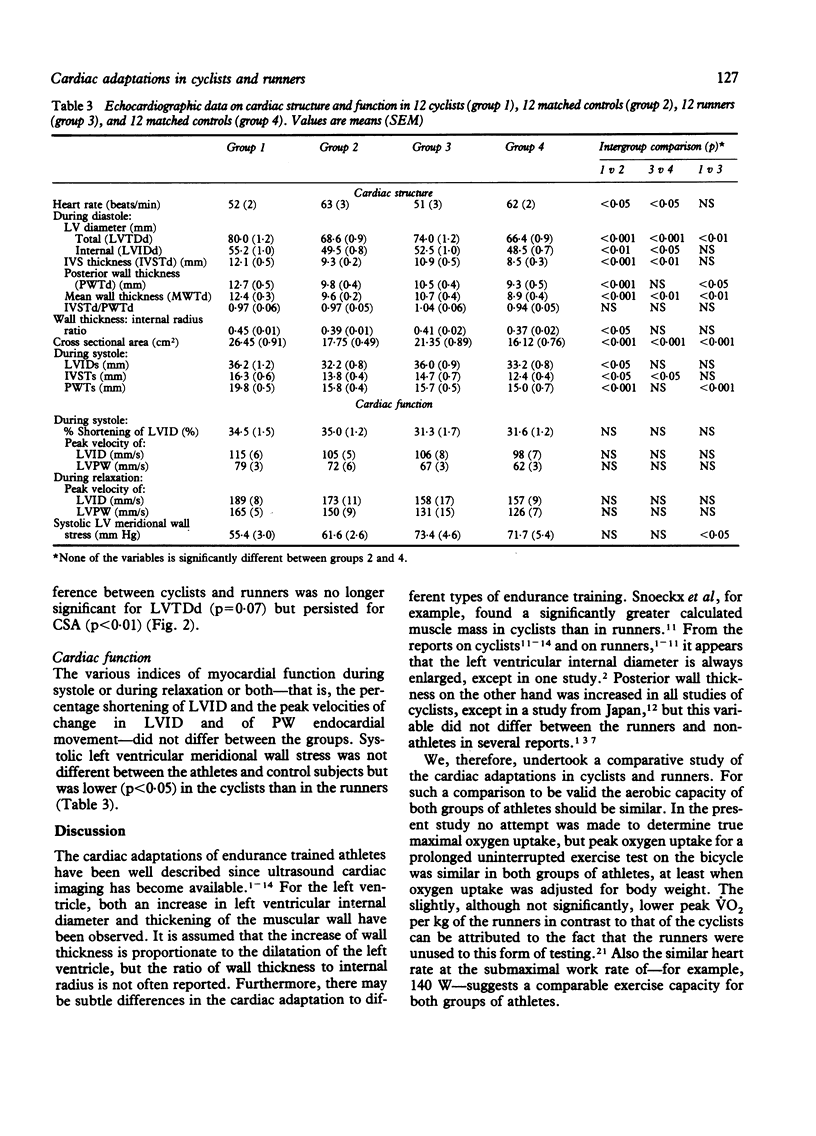

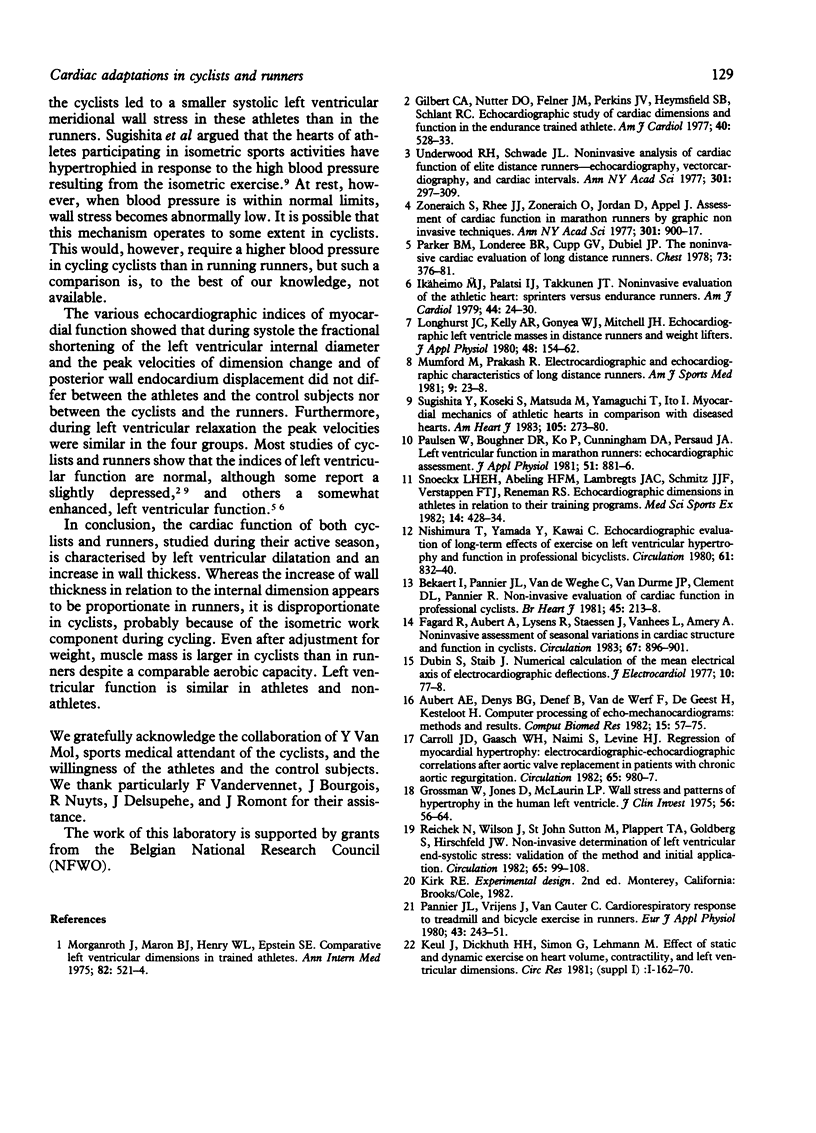
Selected References
These references are in PubMed. This may not be the complete list of references from this article.
- Aubert A. E., Denys B. G., Denef B., Van de Werf F., De Geest H., Kesteloot H. Computer processing of echo-mechanocardiograms: methods and results. Comput Biomed Res. 1982 Feb;15(1):57–75. doi: 10.1016/0010-4809(82)90053-2. [DOI] [PubMed] [Google Scholar]
- Bekaert I., Pannier J. L., Van de Weghe C., Van Durme J. P., Clement D. L., Pannier R. Non-invasive evaluation of cardiac function in professional cyclists. Br Heart J. 1981 Feb;45(2):213–218. doi: 10.1136/hrt.45.2.213. [DOI] [PMC free article] [PubMed] [Google Scholar]
- Carroll J. D., Gaasch W. H., Naimi S., Levine H. J. Regression of myocardial hypertrophy: electrocardiographic-echocardiographic correlations after aortic valve replacement in patients with chronic aortic regurgitation. Circulation. 1982 May;65(5):980–987. doi: 10.1161/01.cir.65.5.980. [DOI] [PubMed] [Google Scholar]
- Dubin S., Staib J. Annotation: Numerical calculation of the mean electrical axis of electrocardiographic deflections. J Electrocardiol. 1977 Jan;10(1):77–78. doi: 10.1016/s0022-0736(77)80036-8. [DOI] [PubMed] [Google Scholar]
- Fagard R., Aubert A., Lysens R., Staessen J., Vanhees L., Amery A. Noninvasive assessment of seasonal variations in cardiac structure and function in cyclists. Circulation. 1983 Apr;67(4):896–901. doi: 10.1161/01.cir.67.4.896. [DOI] [PubMed] [Google Scholar]
- Gilbert C. A., Nutter D. O., Felner J. M., Perkins J. V., Heymsfield S. B., Schlant R. C. Echocardiographic study of cardiac dimensions and function in the endurance-trained athlete. Am J Cardiol. 1977 Oct;40(4):528–533. doi: 10.1016/0002-9149(77)90067-4. [DOI] [PubMed] [Google Scholar]
- Grossman W., Jones D., McLaurin L. P. Wall stress and patterns of hypertrophy in the human left ventricle. J Clin Invest. 1975 Jul;56(1):56–64. doi: 10.1172/JCI108079. [DOI] [PMC free article] [PubMed] [Google Scholar]
- Ikäheimo M. J., Palatsi I. J., Takkunen J. T. Noninvasive evaluation of the athletic heart: sprinters versus endurance runners. Am J Cardiol. 1979 Jul;44(1):24–30. doi: 10.1016/0002-9149(79)90246-7. [DOI] [PubMed] [Google Scholar]
- Longhurst J. C., Kelly A. R., Gonyea W. J., Mitchell J. H. Echocardiographic left ventricular masses in distance runners and weight lifters. J Appl Physiol Respir Environ Exerc Physiol. 1980 Jan;48(1):154–162. doi: 10.1152/jappl.1980.48.1.154. [DOI] [PubMed] [Google Scholar]
- Morganroth J., Maron B. J., Henry W. L., Epstein S. E. Comparative left ventricular dimensions in trained athletes. Ann Intern Med. 1975 Apr;82(4):521–524. doi: 10.7326/0003-4819-82-4-521. [DOI] [PubMed] [Google Scholar]
- Mumford M., Prakash R. Electrocardiographic and echocardiographic characteristics of long distance runners. Comparison of left ventricular function with age- and sex-matched controls. Am J Sports Med. 1981 Jan-Feb;9(1):23–28. doi: 10.1177/036354658100900105. [DOI] [PubMed] [Google Scholar]
- Nishimura T., Yamada Y., Kawai C. Echocardiographic evaluation of long-term effects of exercise on left ventricular hypertrophy and function in professional bicyclists. Circulation. 1980 Apr;61(4):832–840. doi: 10.1161/01.cir.61.4.832. [DOI] [PubMed] [Google Scholar]
- Pannier J. L., Vrijens J., Van Cauter C. Cardiorespiratory response to treadmill and bicycle exercise in runners. Eur J Appl Physiol Occup Physiol. 1980;43(3):243–251. doi: 10.1007/BF00421838. [DOI] [PubMed] [Google Scholar]
- Parker B. M., Londeree B. R., Cupp G. V., Dubiel J. P. The noninvasive cardiac evaluation of long-distance runners. Chest. 1978 Mar;73(3):376–381. doi: 10.1378/chest.73.3.376. [DOI] [PubMed] [Google Scholar]
- Paulsen W., Boughner D. R., Ko P., Cunningham D. A., Persaud J. A. Left ventricular function in marathon runners: echocardiographic assessment. J Appl Physiol Respir Environ Exerc Physiol. 1981 Oct;51(4):881–886. doi: 10.1152/jappl.1981.51.4.881. [DOI] [PubMed] [Google Scholar]
- Reichek N., Wilson J., St John Sutton M., Plappert T. A., Goldberg S., Hirshfeld J. W. Noninvasive determination of left ventricular end-systolic stress: validation of the method and initial application. Circulation. 1982 Jan;65(1):99–108. doi: 10.1161/01.cir.65.1.99. [DOI] [PubMed] [Google Scholar]
- Snoeckx L. H., Abeling H. F., Lambregts J. A., Schmitz J. J., Verstappen F. T., Reneman R. S. Echocardiographic dimensions in athletes in relation to their training programs. Med Sci Sports Exerc. 1982;14(6):428–434. doi: 10.1249/00005768-198206000-00004. [DOI] [PubMed] [Google Scholar]
- Sugishita Y., Koseki S., Matsuda M., Yamaguchi T., Ito I. Myocardial mechanics of athletic hearts in comparison with diseased hearts. Am Heart J. 1983 Feb;105(2):273–280. doi: 10.1016/0002-8703(83)90527-6. [DOI] [PubMed] [Google Scholar]
- Underwood R. H., Schwade J. L. Noninvasive analysis of cardiac function of elite distance runners--echocardiography, vectorcardiography, and cardiac intervals. Ann N Y Acad Sci. 1977;301:297–309. doi: 10.1111/j.1749-6632.1977.tb38208.x. [DOI] [PubMed] [Google Scholar]
- Zoneraich S., Rhee J. J., Zoneraich O., Jordan D., Appel J. Assessment of cardiac function in marathon runners by graphic noninvasive techniques. Ann N Y Acad Sci. 1977;301:900–917. doi: 10.1111/j.1749-6632.1977.tb38257.x. [DOI] [PubMed] [Google Scholar]


